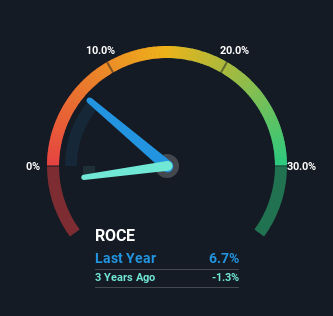These Return Metrics Don't Make Groupon (NASDAQ:GRPN) Look Too Strong
To avoid investing in a business that's in decline, there's a few financial metrics that can provide early indications of aging. Businesses in decline often have two underlying trends, firstly, a declining return on capital employed (ROCE) and a declining base of capital employed. Basically the company is earning less on its investments and it is also reducing its total assets. Having said that, after a brief look, Groupon (NASDAQ:GRPN) we aren't filled with optimism, but let's investigate further.
Return On Capital Employed (ROCE): What Is It?
For those that aren't sure what ROCE is, it measures the amount of pre-tax profits a company can generate from the capital employed in its business. To calculate this metric for Groupon, this is the formula:
Return on Capital Employed = Earnings Before Interest and Tax (EBIT) ÷ (Total Assets - Current Liabilities)
0.067 = US$19m ÷ (US$581m - US$297m) (Based on the trailing twelve months to March 2024).
So, Groupon has an ROCE of 6.7%. Ultimately, that's a low return and it under-performs the Multiline Retail industry average of 11%.
See our latest analysis for Groupon

Above you can see how the current ROCE for Groupon compares to its prior returns on capital, but there's only so much you can tell from the past. If you're interested, you can view the analysts predictions in our free analyst report for Groupon .
What Does the ROCE Trend For Groupon Tell Us?
The trend of ROCE doesn't look fantastic because it's fallen from 12% five years ago and the business is utilizing 60% less capital, even after their capital raise (conducted prior to the latest reporting period).
On a side note, Groupon's current liabilities are still rather high at 51% of total assets. This can bring about some risks because the company is basically operating with a rather large reliance on its suppliers or other sorts of short-term creditors. Ideally we'd like to see this reduce as that would mean fewer obligations bearing risks.
The Bottom Line On Groupon's ROCE
In summary, it's unfortunate that Groupon is shrinking its capital base and also generating lower returns. Unsurprisingly then, the stock has dived 81% over the last five years, so investors are recognizing these changes and don't like the company's prospects. With underlying trends that aren't great in these areas, we'd consider looking elsewhere.
If you'd like to know about the risks facing Groupon, we've discovered 3 warning signs that you should be aware of.
While Groupon may not currently earn the highest returns, we've compiled a list of companies that currently earn more than 25% return on equity. Check out this free list here.
Have feedback on this article? Concerned about the content? Get in touch with us directly. Alternatively, email editorial-team (at) simplywallst.com.
This article by Simply Wall St is general in nature. We provide commentary based on historical data and analyst forecasts only using an unbiased methodology and our articles are not intended to be financial advice. It does not constitute a recommendation to buy or sell any stock, and does not take account of your objectives, or your financial situation. We aim to bring you long-term focused analysis driven by fundamental data. Note that our analysis may not factor in the latest price-sensitive company announcements or qualitative material. Simply Wall St has no position in any stocks mentioned.